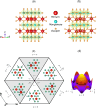Three-dimensional domain identification in a single hexagonal manganite nanocrystal
- PMID: 38678047
- PMCID: PMC11055849
- DOI: 10.1038/s41467-024-48002-z
Three-dimensional domain identification in a single hexagonal manganite nanocrystal
Abstract
The three-dimensional domain structure of ferroelectric materials significantly influences their properties. The ferroelectric domain structure of improper multiferroics, such as YMnO3, is driven by a non-ferroelectric order parameter, leading to unique hexagonal vortex patterns and topologically protected domain walls. Characterizing the three-dimensional structure of these domains and domain walls has been elusive, however, due to a lack of suitable imaging techniques. Here, we present a multi-peak Bragg coherent x-ray diffraction imaging determination of the domain structure in single YMnO3 nanocrystals. We resolve two ferroelectric domains separated by a domain wall and confirm that the primary atomic displacements occur along the crystallographic c-axis. Correlation with atomistic simulations confirms the Mexican hat symmetry model of domain formation, identifying two domains with opposite ferroelectric polarization and adjacent trimerization, manifesting in a clockwise arrangement around the hat's brim.
© 2024. The Author(s).
Conflict of interest statement
The authors declare no competing interests.
Figures





Similar articles
-
Observation of vortex domain structures in multiferroic hexagonal manganites RMnO3 by transmission electron microscopy.Microscopy (Oxf). 2014 Nov;63 Suppl 1:i22. doi: 10.1093/jmicro/dfu067. Microscopy (Oxf). 2014. PMID: 25359818
-
Phase-field simulation on the interaction of oxygen vacancies with charged and neutral domain walls in hexagonal YMnO3.J Phys Condens Matter. 2022 Feb 21;34(16). doi: 10.1088/1361-648X/ac50d8. J Phys Condens Matter. 2022. PMID: 35105837
-
Insulating interlocked ferroelectric and structural antiphase domain walls in multiferroic YMnO3.Nat Mater. 2010 Mar;9(3):253-8. doi: 10.1038/nmat2632. Epub 2010 Feb 14. Nat Mater. 2010. PMID: 20154694
-
Direct observation of multiferroic vortex domains in YMnO3.Sci Rep. 2013;3:2741. doi: 10.1038/srep02741. Sci Rep. 2013. PMID: 24061552 Free PMC article.
-
A Review of Domain Modelling and Domain Imaging Techniques in Ferroelectric Crystals.Materials (Basel). 2011 Feb 16;4(2):417-447. doi: 10.3390/ma4020417. Materials (Basel). 2011. PMID: 28879998 Free PMC article. Review.
Cited by
-
Imaging of electric-field-induced domain structure in DyMnO nanocrystals.Discov Nano. 2024 Dec 15;19(1):203. doi: 10.1186/s11671-024-04165-8. Discov Nano. 2024. PMID: 39674963 Free PMC article.
References
-
- Rabe, K., Ahn, C. & Triscone, J. Physics of Ferroelectrics (Springer Berlin, Heidelberg, 2007).
-
- Meier, D., Seidel, J., Gregg, M. & Ramesh, R. Domain Walls: From Fundamental Properties to Nanotechnology Concepts (Oxford University Press, 2000).
-
- Fennie C, Rabe K. Ferroelectric transition in YMnO3 from first principles. Phys. Rev. B. 2005;72:100103. doi: 10.1103/PhysRevB.72.100103. - DOI
LinkOut - more resources
Full Text Sources

